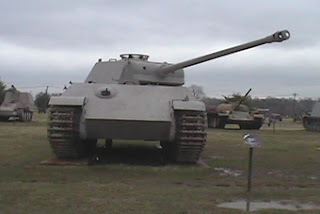by Phil Gardocki
Contact with the Soviet T34’s and KV-1’s, was a big shock to the German Army. There were plans for the Panzer V to be just a copy the T-34, but in the end there was a policy decision to never again be technically inferior and it was decided that the Panther should be much better.
 |
Panther Model A Note, the rounded turret design, which served to send ricochets into the hull. As photographed by the author. Used with permission from the US Army Ordnance Museum. |
The requirements was set to 10 cm of sloping armor. And with a 7.5cm/L70 gun, which could penetrate 16cm of armor at 500 meters. It was designated as a medium tank, but it was all but equal to the heavier Tiger tank.
After an initial production run of 600 units, Model ‘D’, was discontinued for many mechanical problems. The fuel pump was a high failure item, and the engine tended to shear the starboard side mounting bolts. These problems were resolved with Model ‘A’, which ran 1,700 units. The final run, model ‘G’, reshaped the turret front, that had a tendency to trap shots, sending them into the hull at an unfavorable angle. 3,700 units were made.
For the battle of Kursk, 200 Panthers were deployed to the 10th Panzer Brigade. 46 more were assigned to Panzer Grenadier Division Grossdeutschland. Most of the Panthers were disabled by mechanical failures, some caught on fire while being unloaded from the train! Despite these problems, the Panthers were accredited with over 240 kills. Most of the Panthers damaged at Kursk were recovered and repaired. A few days into Operation Citadel, the remaining Panthers of the 10th Panzer Brigade were assigned to Panzer Grenadier Division Grossdeutschland. As production allowed, panzer divisions were slowly upgraded. Each division having one of its panzer battalions upgraded to a Panther battalion.
On the field, the Panther was the finest tank of the war. It was quick and could handle mud. Between its optics and long 7.5cm gun, it could pick off all but the heaviest armored vehicles at 3,000 meters. It’s sloping 10cm of armor could handle any antitank round at all but the shortest ranges.
| Panther Model A | Specification | Jadgpanther | Specification |
| Gun | 7.5cm L70 | Gun | 8.8cm L71 |
| Weight | 43 tonnes | Weight | 45 tonnes |
| Max Hull Armor | 8 cm | Max Hull Armor | 8 cm |
| Max Turret Armor | 11 cm | Max Gun Mantlet Armor | 10 cm |
| Engine size | 23 liter | Engine size | 23 liter |
| Fuel | 74 octane Gasoline | Fuel | 74 octane Gasoline |
| Horsepower | 700hp, 515kw | Horsepower | 700hp, 515kw |
| Top Speed | 55 kph* | Top Speed | 55 kph* |
| Crew | 5 | Crew | 5 |
*Though, the engine burned so hot, that a governor was installed
limiting the speed to 45kph.
limiting the speed to 45kph.
| Panther Model G The flat bottom turret redesign, fixed the "Tank Trap" problem. As photographed by the author. Used with permission from the US Army Ordnance Museum. |

No comments:
Post a Comment